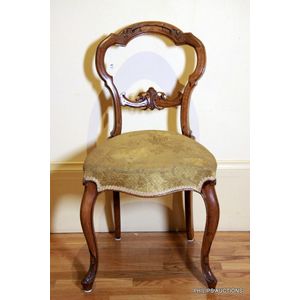Victorian Mahogany Balloon Back Chairs
You must be a subscriber, and be logged in to view price and dealer details.
Subscribe Now to view actual auction price for this item
When you subscribe, you have the option of setting the currency in which to display prices to $Au, $US, $NZ or Stg.
- Mahogany - Mahogany is a dense, close grained red-coloured timber from the West Indies and Central America. It was first imported into Europe in the the early 18th century and its use continued through the 19th century. It was popular for furniture making because of its strength, the wide boards available, the distinctive grain on some boards, termed flame mahogany and the rich warm colour of the timber when it was polished.. The "flame" was produced where a limb grew out from the trunk of the tree, and this timber was usually sliced into veneers for feature panels on doors, backs and cornices.
Some terms used to describe mahogany relate to the country from which it originally came, such as "Cuban" mahogany, "Honduras" mahogany etc. However unless the wood has been tested the names assigned are more a selling feature, rather than a true indication of the timber's origin. - Victorian Period - The Victorian period of furniture and decorative arts design covers the reign of Queen Victoria from 1837 to 1901. There was not one dominant style of furniture in the Victorian period. Designers used and modified many historical styles such as Gothic, Tudor, Elizabethan, English Rococo, Neoclassical and others, although use of some styles, such as English Rococo and Gothic tended to dominate the furniture manufacture of the period.
The Victorian period was preceded by the Regency and William IV periods, and followed by the Edwardian period, named for Edward VII (1841 ? 1910) who was King of the United Kingdom and the British Dominions and Emperor of India for the brief period from 1901 until his death in 1910. - Jacquard Fabric - Jacquard fabric is woven on a jacquard loom, which allows intricate and complex patterns to be created. The jacquard loom is controlled by a system of punched cards or a computer program that controls the movement of the loom and allows for the creation of complex patterns in the fabric.
Jacquard fabric is known for its elaborate and detailed designs, which can include intricate floral patterns, geometric designs, and other complex motifs. The patterns are woven into the fabric, rather than printed or embroidered, which gives them a unique texture and depth.
Jacquard fabrics can be made from a variety of fibress, including silk, cotton, wool, and synthetic materials. They are often used for upholstery, drapery, and other decorative applications, as well as for clothing such as dresses, suits, and jackets. - Cabriole Leg - The cabriole leg evolved from an elongated scroll, curving out at the knee which may or may not be carved, and forming a serpentine shape as it descends to the foot.
First introduced into English furniture in the late 17th century, cabriole legs were widely used during the Queen Anne and early Georgian periods, where they frequently terminated in a pad foot or ball and claw foot. The style has had many imitators since then. The cabriole leg was re-introduced in the mid-19th century, and is commonly associated with the balloon-back dining or drawing-room chairs made in walnut, mahogany or, in Australia, cedar. The Victorian cabriole leg, on the whole, was rather more slender than the earlier form, following the French style, which emphasized the delicacy and daintiness of the chairs they were designed to support. Cabriole legs are sometimes found on windsor chairs, especially those made during the 18th century. - Serpentine - Resembling a serpent, in the form of an elongated 'S'. A serpentine front is similar to a bow front, except that the curve is shallow at each end, swelling towards the middle. The term presumably derives from its similarity to a moving snake or serpent. Serpentine fronts are usually veneered, with the carcase either being cut and shaped from a solid piece of timber, or built in the 'brick' method.
This item has been included into following indexes:
-
chairs, sets of 6, style or period
- balloon back 83
- French 171
- Victorian 218
-
chairs, sets of 6, timber
- all styles and timbers 747
- mahogany 175
Visually similar items

A set of four Victorian mahogany balloon back chairs, circa 1890, of typical waisted form with a rounded crest, and a scrolled mid rail with a pierced floral motif above a shaped stuffover seat in olive green velvet, on a cabriole leg. Height 86.5 cm

A set of four Victorian pale mahogany dining chairs, 19th century, the balloon back chairs with trefid crests carved with bud and clover designs, pierced vegetal motifs to the mid rails, stuffover seats and cabriole legs with pointed toes, height 89 cm, wi

A set of six Victorian walnut balloon back chairs, 19th century, the trefid crested chairs with relief carved embellishments, scroll and leaf form mid rails above serpentine stuffover seats and raised on curvaceous legs, with embossed light olive velvet up

A Victorian walnut balloon back chair, later 19th century, in the French manner with a shaped, waisted back, a pierced and carved crest and a similarly embellished mid rail, a serpentine stuffover seat and raised on channel grooved cabriole legs terminatin
